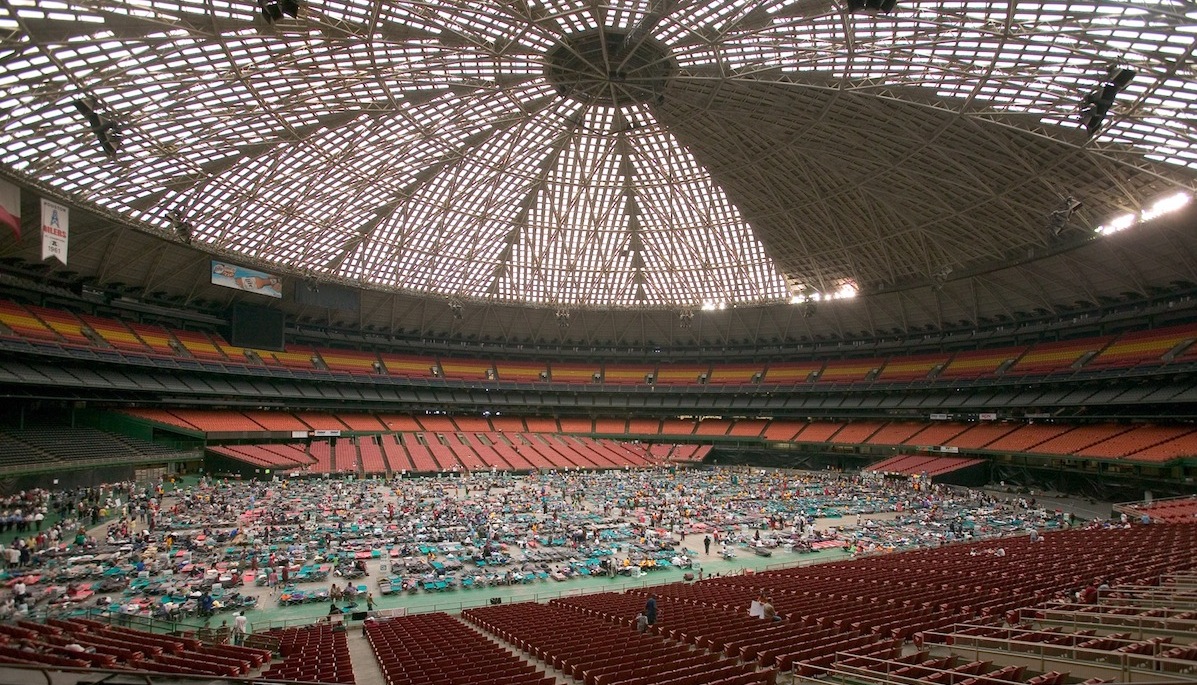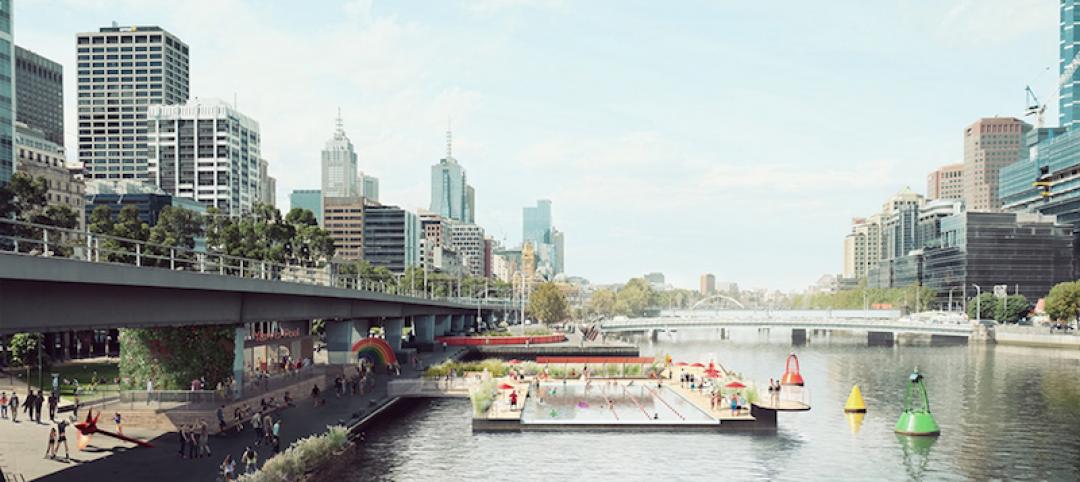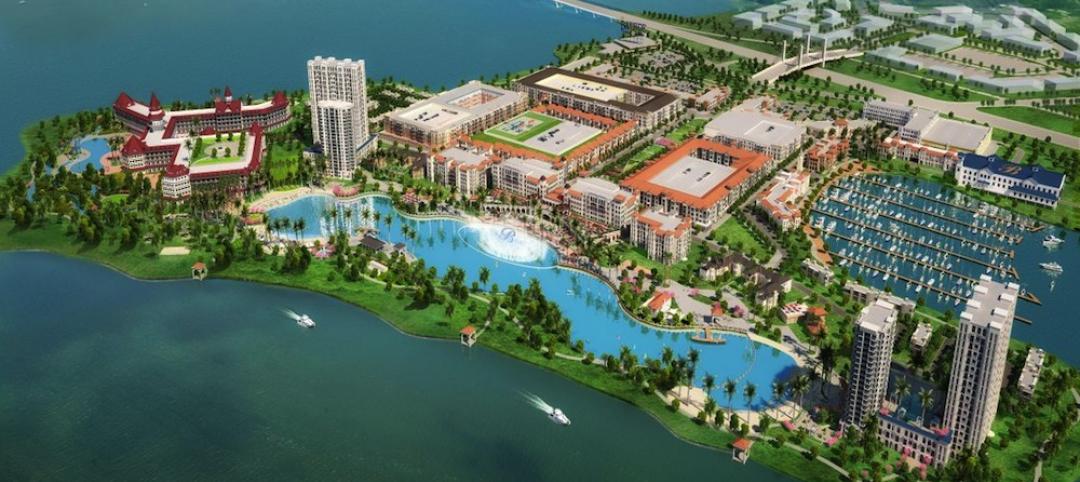An advisory panel of developers, architects, business leaders, and other land-use experts has proposed turning Houston’s decrepit Astrodome, which has been vacant since 2008, into a multipurpose park and civic, programmable space for festivals, concerts, and exhibits.
This is the latest in a series of proposals that, over the past few years, have been floated and, to this point, rejected. They have included converting the Astrodome into a luxury hotel and a movie studio.
In November 2013, voters turned down a $213 million referendum to renovate the building into a convention center and exhibition space. A month later, the Astrodome’s three exterior pedestrian ramp towers were torn down. The National Trust for Historic Preservation has listed the Astrodome among the 11 most endangered historic places.
But the city’s council has rejected the Astrodome’s outright demolition until its final disposition is determined, and because the council fears razing a structure this large could cause damage to the surrounding development.
Houston's city council has rejected the Astrodome’s outright demolition until its final disposition is determined, and because the council fears razing a structure this large could cause damage to the surrounding development.
The one-million-sf, spaceship-shaped building was the world’s first multipurpose domed sports stadium. It is now called NRG Astrodome, and is part of the 350-acre NRG Park complex in Harris County, Texas, which includes a stadium with a retractable roof where the National Football League’s Houston Texans franchise plays, and an arena wherre the popular Houston Livestock Show and Rodeo is held. NRG Park is also near Texas Medical Center, the world’s largest.
Last December, the county and the National Trust for Historic Preservation turned to Urban Land Institute to provide strategic advice. (Harris County’s Sports and Convention Corporation had chimed in, too, suggesting the space be used as a public park.) ULI sent a 10-person Advisory Services Panel, chaired by Los Angeles developer Wayne Ratkovich, to visit the Astrodome for three days. That panel came up with a series of recommendations, which ULI released on March 24.
The panel acknowledges that the Astrodome was now “a shadow of its former self.” But it also refers to the building as an “icon,” whose place in history should be part of any renovation plan. A “new vision” for the stadium, the panel states, could include a museum or educational exhibits that focus on science, technology, engineering, the arts, and math.
The panel’s report lays out a detailed renovation strategy:
• 1,500 parking spaces would be added to the 26,000 slots that already surround the building. That parking would be located in the building’s Levels 1 and 2, with the lower level having 20-foot-high clearance.
• Level 3, which currently consists of vast open space and seating trays, would be converted into a new ground-floor multi-use space that, ULI suggests, could include a public park.
• Levels 4 through 8 would be converted to new programmable areas, such as exhibits “to extend the game-day experience for the Houston Texas, new spaces for [the rodeo] and added space for the Offshore Technology Conference. (One of the key goals of ULI’s plan is to lure the rodeo event back into the Astrodome. The rodeo relocated in 2003.) These programmable spaces could also be used for community festivals, farmers markets, movie nights, charity events and other functions that might also provide new revenue streams.
The panel envisions 450,000 sf of leasable space within the Astrodome’s perimeter, which could accommodate restaurants, retail, and other tenants.
Other recommendations include a complete rehab of the building’s dome, and the creation of new outdoor public space or a live oak allée as a promenade between the light-rail station and the Astrodome’s east entrance. Along that allée there would be permanent outdoor pavilions. The building’s outside area would be upgraded with hardscape and landscape features.

The construction cost for this project, estimates the panel, would be around $242.45 million. (The Astrodome opened in 1965 at a cost of $35 million in taxpayer money.) The panel recommends that new capital streams to pay for this construction would need to be explored, including federal, state, county, and city funds; tax increment reinvestment zones; historic tax credits; Harris County redevelopment; and philanthropy.
To get all moving forward, the panel says the county should assign a project “czar,” as well as identify and empower an NRG Park “champion,” perhaps from the ranks of business or not-for-profit organizations.
Independent marketing and design consultants would need to be hired, and after a plan is conceived, it should be submitted to public scrutiny, says the panel.
The goal would be to complete this plan and break ground on the renovation before the 2017 Super Bowl, so that it could be advertised during the event. The panel expects the renovation to take a year or two to complete, and foresees “future public/private project opportunities”—including hotel, mixed-use, and retail development—in the years 2020-2025.
In its report, the panel says Harris County and its residents are at “an intersection of a series of choices: to act rather than procrastinate, to demand quality rather than settle on mediocrity, to create a common interest rather than simply protect self interests, [and] to [either] protect the status quo or reach for the future.”
Related Stories
Sports and Recreational Facilities | Jun 9, 2016
Swimming may be returning to Melbourne’s polluted Yarra River… kind of
The addition of a pool to the Yarra may help improve people’s perception of the river and act as the impetus to an increase in support for improving its water quality.
Building Team Awards | May 23, 2016
'Greenest ballpark' proves a winner for St. Paul Saints
Solar arrays, a public art courtyard, and a picnic-friendly “park within a park" make the 7,210-seat CHS Field the first ballpark to meet Minnesota sustainable building standards.
Sports and Recreational Facilities | May 20, 2016
Texas Rangers announce plans for $1 billion retractable roof ballpark
The new stadium will replace Globe Life Park, which is only 22 years old.
Sports and Recreational Facilities | May 19, 2016
Audacy brings wireless lighting controls to Wrigley Field’s new clubhouse
The Audacy system uses a combination of motion sensors, luminaire controllers, light sensors, and switches that are all connected and coordinated by Gateways.
Sports and Recreational Facilities | May 6, 2016
NBA’s Atlanta Hawks to build new practice center with attached medical facilities
The team will have easy access to an MRI machine, 3D motion capture equipment, and in-ground hydrotherapy.
BIM and Information Technology | May 2, 2016
How HDR used computational design tools to create Omaha's UNO Baxter Arena
Three years after writing a white paper about designing an arena for the University of Nebraska Omaha, HDR's Matt Goldsberry says it's time to cherry-pick the best problem-solving workflows.
Mixed-Use | May 1, 2016
A man-made lagoon with a Bellagio-like fountain will be the highlight of a mixed-use project outside Dallas
Construction will soon begin on housing, retail, and office spaces.
Sports and Recreational Facilities | Apr 17, 2016
An expanded and renovated complex brings together U. of Colorado’s sports programs
This two-year project enhances the experiences of athletes and fans alike.
Sports and Recreational Facilities | Apr 13, 2016
Cubs take a measured approach when planning HD video boards
Along with the mammoth and super-sharp video boards, Wrigley Field's 1060 Project includes renovated bleachers, upgraded player amenities, and more concourses, decks, and concessions.
Sports and Recreational Facilities | Apr 13, 2016
More than a game: 4 ways sports teams are adapting to changing fan preferences
As the cost of tickets, parking, and concessions skyrockets, while home theater technology becomes more affordable, fans wonder: Why even bother going to the game? Here’s how progressive sports owners and Building Teams are packing stadium seats.
















